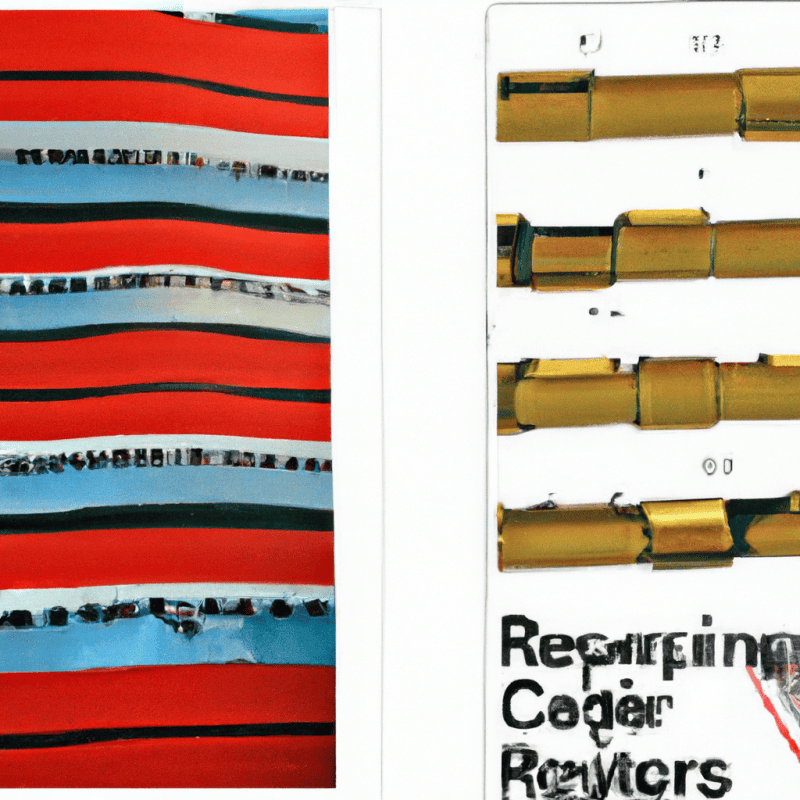resistance bands
Fabric vs Plastic: Which Resistance Bands Are Better?
You’re ready to take your fitness routine to the next level, but when it comes to choosing the right resistance bands, you’re faced with a tough decision: fabric or plastic? Both options offer their unique advantages and vary in terms of durability, versatility, and resistance levels. In this article, we’ll explore the pros and cons of each type of resistance band, helping you make an informed choice so you can achieve your fitness goals with confidence. So, let’s dive into the world of fabric vs plastic resistance bands and discover which one is better suited for your workout needs.

Durability
Fabric bands
Fabric bands are known for their durability and long-lasting performance. They are typically made from high-quality materials such as strong woven fabric and reinforced stitching, which make them resistant to tears and breaks. Fabric bands have proven to withstand intense workouts and repeated stretching without losing their shape or effectiveness. This durability ensures that you can enjoy using fabric bands for a long time without the need for frequent replacements.
Plastic bands
On the other hand, plastic bands also offer good durability. They are usually made from a high-grade synthetic polymer that is designed to withstand extended use and frequent stretching. While plastic bands may not be as durable as fabric bands, they still provide a satisfactory level of durability for most exercise routines. However, it is important to note that plastic bands may be more prone to breaking or snapping, especially if they are subjected to excessive force or stretched beyond their limits.
Resistance Levels
Fabric bands
Fabric bands come in a wide range of resistance levels, making them suitable for users of all fitness levels. They are available in different thicknesses and lengths, each representing a different resistance level. It allows you to choose the band that offers the right amount of resistance for your specific needs and goals. Whether you are a beginner or an advanced fitness enthusiast, fabric bands can provide you with the appropriate resistance to challenge your muscles and help you progress in your fitness journey.
Plastic bands
Plastic bands, similar to fabric bands, also come in various resistance levels. They are often color-coded to indicate the level of resistance each band provides. This allows users to easily identify and select the band that suits their desired intensity for different exercises. Plastic bands are particularly beneficial for users who require less resistance or are just starting their fitness journey. However, it is important to note that some plastic bands may have limited resistance options compared to fabric bands.
Material Quality
Fabric bands
When it comes to material quality, fabric bands are generally considered superior. They are usually made from high-quality cotton or polyester fabric that is not only durable but also comfortable against the skin. The high-quality materials used in fabric bands ensure that they do not irritate or rub against your skin, even during intense workouts. The fabric’s elasticity and flexibility also allow for a full range of motion, making exercises more comfortable and efficient.
Plastic bands
Plastic bands, while not as high in material quality as fabric bands, still offer decent performance. They are typically made from latex or other synthetic materials that provide good elasticity and durability. However, some users may find that plastic bands can feel slightly rigid or less comfortable compared to fabric bands. This can be a factor to consider if you have sensitive skin or prefer a softer feel during your workouts.
Comfort and Feel
Fabric bands
Fabric bands are often praised for their comfortable and soft feel against the skin. The woven fabric material used in these bands offers a smooth and non-irritating surface that minimizes friction during exercises. This ensures a pleasant experience and reduces the chances of discomfort or potential skin irritation that may occur with other types of resistance bands. The fabric’s gentle touch makes fabric bands a popular choice for individuals who prioritize comfort during their workout routines.
Plastic bands
Plastic bands may not offer the same level of comfort as fabric bands due to their smooth and synthetic nature. However, many plastic bands are designed with textured surfaces or handles to improve grip and enhance comfort during use. While they may not provide the same softness as fabric bands, plastic bands can still offer a satisfactory level of comfort, especially if you prefer a firmer and more secure feel during your workouts.

Versatility
Fabric bands
Fabric bands are highly versatile and can be used for a wide range of exercises and fitness routines. They can be easily incorporated into various exercises, from strength training to Pilates, yoga, and rehabilitation exercises. Fabric bands can target different muscle groups, including the arms, legs, glutes, and core, making them a versatile tool for full-body workouts. Additionally, fabric bands can be adjusted for different resistance levels by either folding or gripping different parts of the band, allowing for greater versatility in your workouts.
Plastic bands
Similar to fabric bands, plastic bands also offer versatility in terms of exercise options. They can be used for strength training, toning, and rehabilitation exercises. Plastic bands typically come in different lengths and resistances, providing the opportunity to target various muscle groups with varying intensities. The lightweight and compact nature of plastic bands also make them convenient for travel or on-the-go workouts. Whether you are a beginner or a seasoned fitness enthusiast, plastic bands can provide versatility in your exercise routine.
Portability
Fabric bands
Fabric bands are lightweight and compact, making them highly portable. They can be easily rolled up or folded, allowing you to fit them into your gym bag, backpack, or suitcase without taking up much space. This portability makes fabric bands a great choice for individuals who frequently travel or want to take their workouts outside of their home or gym environment. You can conveniently bring fabric bands with you to the park, beach, or any other location to maintain your fitness routine wherever you go.
Plastic bands
Plastic bands are also lightweight and portable, making them a convenient option for exercising on the go. They can be easily stored in a small bag or even your pocket, allowing you to take them with you wherever you need to go. Plastic bands are particularly useful for individuals who want to incorporate resistance training into their daily activities, whether it’s at the office, during a vacation, or simply when you have limited space available. Their compact size and portability make plastic bands a practical choice for maintaining your fitness routine no matter where you are.

Cost
Fabric bands
Fabric bands are generally affordable and offer good value for money. They are available in a range of price points, allowing you to choose the band that fits your budget. While higher-quality fabric bands may be slightly more expensive, they are often worth the investment due to their durability and long-lasting performance. Considering the versatility and effectiveness of fabric bands, their cost is relatively affordable compared to other fitness equipment or gym memberships.
Plastic bands
Plastic bands are typically more budget-friendly compared to fabric bands. They are available at a lower price point, making them a cost-effective option for individuals who are on a tighter budget. Plastic bands can provide a decent level of resistance for various exercises without breaking the bank. However, it is important to note that the durability and longevity of plastic bands may vary depending on their quality, and you may need to replace them more frequently compared to higher-quality fabric bands.
Eco-Friendliness
Fabric bands
Fabric bands are considered more eco-friendly compared to plastic bands. They are often made from organic or recycled materials, reducing the environmental impact of their production. Additionally, fabric bands are often biodegradable, meaning they will break down over time and pose less harm to the environment compared to plastic bands, which are non-biodegradable. By choosing fabric bands, you can contribute to a more sustainable and eco-conscious fitness routine.
Plastic bands
Plastic bands, unfortunately, have a higher environmental footprint compared to fabric bands. Most plastic bands are made from synthetic materials that are not biodegradable and can contribute to pollution and waste. However, some plastic bands are made from recycled or eco-friendly materials, which can be a more sustainable option. If environmental sustainability is a key factor for you, it may be worth researching and opting for plastic bands that are specifically marketed as eco-friendly or made from recycled materials.

Safety
Fabric bands
Fabric bands are generally safe to use, as long as they are used correctly and within their designated resistance limits. The woven fabric material provides a secure grip and minimizes the chance of the band slipping or snapping during exercises. However, it is important to regularly inspect fabric bands for any signs of wear or damage, as this can affect their safety and performance. If you notice any fraying, tears, or weakened areas, it is advisable to replace the band to avoid potential accidents or injuries.
Plastic bands
Plastic bands, like fabric bands, are safe to use when used appropriately and within their intended resistance levels. However, due to their nature, plastic bands may have a slightly higher risk of snapping or breaking compared to fabric bands. It is crucial to follow safety guidelines, such as not overstretching the bands or using them with sharp or abrasive surfaces, to minimize the risk of accidents or injuries. Regularly checking the bands for any signs of wear and tear is also important to ensure their safety and reliability.
Maintenance
Fabric bands
Fabric bands generally require minimal maintenance. After each use, it is recommended to wipe them clean with a damp cloth to remove any sweat or dirt. If necessary, fabric bands can be hand-washed using mild soap and water, but it is important to thoroughly rinse and air dry them to prevent the fabric from deteriorating. Avoid using harsh chemicals, bleach, or machine washing and drying, as these can weaken the fabric and affect the band’s performance and durability. By following these maintenance tips, you can prolong the lifespan of your fabric bands.
Plastic bands
Plastic bands are also low-maintenance and easy to care for. Similar to fabric bands, wiping them clean with a damp cloth after each use is recommended to remove any sweat or debris. However, plastic bands should not be submerged in water or soaked, as this can damage the elasticity and integrity of the material. It is important to store plastic bands in a dry and cool place to prevent them from becoming brittle or damaged. With proper care and regular inspection for wear and tear, plastic bands can maintain their performance and durability over time.


